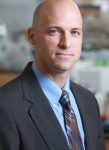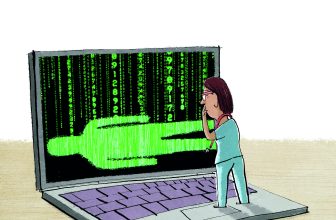
David T. Corr, PhD – ORS
 Professor (Full), Biomedical Engineering
Professor (Full), Biomedical Engineering
Director, Center for Modeling, Simulation, and Imaging in Medicine (CeMSIM)
Rensselaer Polytechnic Institute
Brief Bio:
I earned my B.S. and M.S. degrees in Engineering Mechanics & Astronautics at the University of Wisconsin-Madison (UW), worked briefly as a consultant at NASA’s Jet Propulsion Laboratory, then returned to the UW for my M.S. in Biomedical Engineering and Ph.D. in Mechanical Engineering. After one-year as a research associate in skeletal muscle injury at the UW Medical School, I moved to the University of Calgary for postdoctoral training in muscle physiology and modeling at the Human Performance Laboratory, and joint injury and arthritis research at the McCaig Centre. In 2006 I joined the faculty at Rensselaer Polytechnic Institute (RPI), and am currently a Full Professor in the Department of Biomedical Engineering.
Who have been your mentors?
I have benefited from a fantastic, and varied, collection of mentors over the years. My interest in graduate school was initially sparked by courses and research projects with Bela Sandor in applied mechanics. During my doctorate, I was jointly mentored by Thomas Best and Ray Vanderby Jr., in skeletal muscle and tendon/ligament research, respectively. In Calgary, I extended my appreciations of muscle during my postdoc with Walter Herzog, and osteoarthritis and wound healing working with Nigel Shrive, Dave Hart, and the late Cy Frank. I also benefitted from ”unofficial” career mentoring by Farsh Guilak and Savio L-Y. Woo, particularly as junior faculty. Together, these individuals shaped the scientist and mentor that I am today, and I credit the outstanding examples set by Ray, Nigel, and Dave for instilling my passion for collaborative academic research.
What are your specific research areas and expertise?
My research program aims to understand the impact of various microenvironmental and developmental stimuli on cell behavior, and to exploit these to improve functional tissue engineering and in vitro diagnostics. Our bioprinting work focuses primarily on creating and assessing living 3D breast cancer models. In orthopaedic research, we employ a scaffold-free approach to engineer tendon and skeletal muscle at the single-fiber scale, with a novel bioreactor to deliver precise mechanical, electrical, and chemical stimuli during fiber development and maturation.
What are you currently working on?
Using our scaffold-free single-fiber platform, we are investigating the influence of hypoxia, macromolecular crowding, and cyclic mechanical stimulation – as well as their potential synergies – on the biomechanical function of our engineered tendon fibers. We seek to identify how these stimuli can be effectively leveraged to enhance biomechanical performance and/or accelerate functional maturation.
What has been the biggest challenge for you in your research?
My biggest challenges are in maintaining research funding and the continuity in experimental expertise. Every PI must attract funding to sustain their research programs, so that is not unique to me. However, many of our experimental techniques are specific to my lab and/or at an atypical scale (e.g., single fiber biomechanical characterization), which poses unique challenges for trainees. These processes lie somewhere between a scientific technique and art, and are best learned by doing. This makes the timing of student recruitment critical, so that new students can learn from the more senior ones, and ensure continuity in experimental techniques.
What project(s) are you looking forward to in the near future?
We conduct parallel research in muscle, and have shown the benefits of combined mechanical and electrical stimulation on engineered skeletal muscle fibers. I am excited to merge the muscle and tendon sides of my research, toward engineering functional muscle-tendon units. Additionally, I am interested in the interplay between skeletal muscle and tendon during development, and have just begun a collaboration with Nathan Schiele (ORS Tendon Section member) to study how skeletal muscle signaling can enhance engineered tendon.
What do you want to do next in your career?
I recently became the director of an institute-wide research center, which is a new role that requires a very different skillset than what I have needed as a PI. Despite having been in this position for over a year, I am continually learning new things, so the “next” thing I want to do is grow in my Center Director role.
What advice would you give young investigators in the field?
To any young investigators, I strongly recommend getting involved in your scientific societies (like ORS and the Tendon Section). Although you may be a member of a multiple societies, your time is a limited resource, and I feel it is more impactful for your career to contribute meaningfully to a few select societies, rather than contributing somewhat superficially to many different ones. It is a great way to meet people in the field, provide meaningful service to your scientific research community, and even help shape the direction of future conferences/meetings.
When you’re not in the lab, what do you like to do for fun?
Outside of work, I enjoy cycling – going on a long road ride is my version of therapy. Back in graduate school and my postdoc years, my free time was dominated by road/track cycling, snowboarding, and music (saxophone). Now that my kids are in college and out of the house, I am excited to get back into these more.
What resources would you like to see available from the ORS Tendon Section?
I cannot think of any additional resources, but I would love for the ORS Tendon Section to continue to run the stand-alone meeting, as well as scheduled Tendon Section events within the ORS Annual Meeting. Getting tendon (and ligament) researchers together for a focused 1-2 day meeting is a fantastic way to highlight the latest research and foster discussions with leaders in the tendon research community. The ORS Tendon Section meeting, as well as the former one-day ISL&T meeting, have been instrumental in my own academic and professional development, as well as that of my students.
How can we follow you?
Lab Website | ResearchGate | LinkedIn

 Professor (Full), Biomedical Engineering
Professor (Full), Biomedical Engineering

